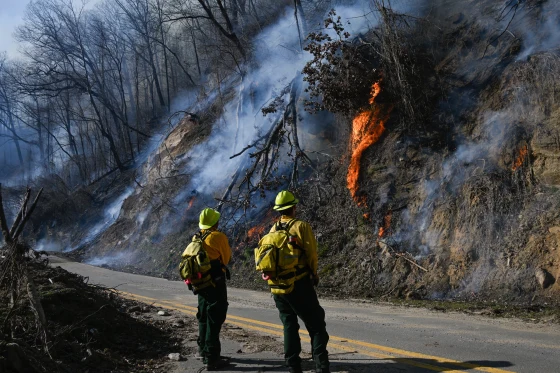Wildfires continue to spread across parts of North and South Carolina, fueled by dry conditions and drought. Authorities have issued evacuation orders and mobilized additional firefighting resources to contain the blazes.
Escalating Wildfires in North Carolina
In western North Carolina, multiple fires have been burning through dry woodlands, prompting emergency declarations and federal assistance. Polk County is facing three major fires—collectively known as the Black Cove Complex Fires—forcing evacuations and drawing in additional firefighting teams, including 25 firefighters from Oregon.
The Black Cove Fire, which ignited in Green River Gorge, has already scorched more than 2,000 acres and remains completely uncontained, according to the North Carolina Department of Agriculture and Consumer Services. Over the weekend, new evacuation orders were issued for five roadways in the area, while some previous evacuees were allowed to return home.
Despite challenging conditions, firefighters expressed optimism about their containment efforts. “We’re holding that fire in that creek drainage. We haven’t had any movement on it,” said Brian Rogers, a state forest ranger managing the federal response.
The Deep Woods Fire, burning nearby, has consumed more than 2,500 acres with 0% containment, prompting additional evacuations. Crews are focused on protecting structures along the southern edge of the blaze. Meanwhile, the Fish Hook Fire, which has burned 199 acres, is now 50% contained, allowing officials to lift evacuation orders in that area.
A fourth wildfire was spotted over the weekend, though officials are still determining whether it is a new blaze or an extension of the existing fires.
Statewide Emergency Response
North Carolina Governor Josh Stein announced that the Federal Emergency Management Agency (FEMA) has approved a grant to support firefighting efforts. The state Forest Service has imposed a statewide burn ban to prevent further fire outbreaks.
“Our top priority is always to protect lives, property, and forestland across the state,” said Agriculture Commissioner Steve Troxler. “It is imperative that folks adhere to this burn ban until further notice.”
South Carolina Fires Grow Amid Dry Conditions
In South Carolina, wildfires are also posing a major threat. The Table Rock Fire, burning in Pickens County, has grown to 1,300 acres with 0% containment. Governor Henry McMaster declared a state of emergency, allowing state resources to be deployed for firefighting efforts.
Fire crews have made some progress by creating fire breaks and conducting controlled burns to eliminate dry vegetation that could fuel the wildfire. “The burnout, which remains in progress, is being deemed successful,” the South Carolina Forestry Commission stated.
Another fire, the Persimmon Ridge Fire, quickly expanded from 50 acres to roughly 800 acres on Sunday. Authorities have now combined it with the Table Rock Fire under the Table Rock Complex Fire, which covers thousands of acres across the Mountain Bridge Wilderness Area.
Firefighters are facing additional challenges due to an excess of fallen trees left behind by Hurricane Helene, which struck the region in September. These downed trees have increased fuel loads, making it easier for the fires to spread.
Weather Conditions and Fire Outlook
The National Weather Service issued red flag warnings across the Carolinas over the weekend due to high temperatures, gusty winds, and low humidity levels, all of which contribute to extreme fire danger.
While some rain is expected early in the week, forecasters warn that fire-prone conditions may persist through Saturday, increasing the risk of further outbreaks. Almost all of North and South Carolina are currently classified as either abnormally dry or experiencing moderate drought, according to the U.S. Drought Monitor.
Authorities continue to urge residents to remain vigilant, follow evacuation orders, and adhere to the burn ban as efforts to contain the wildfires continue.







